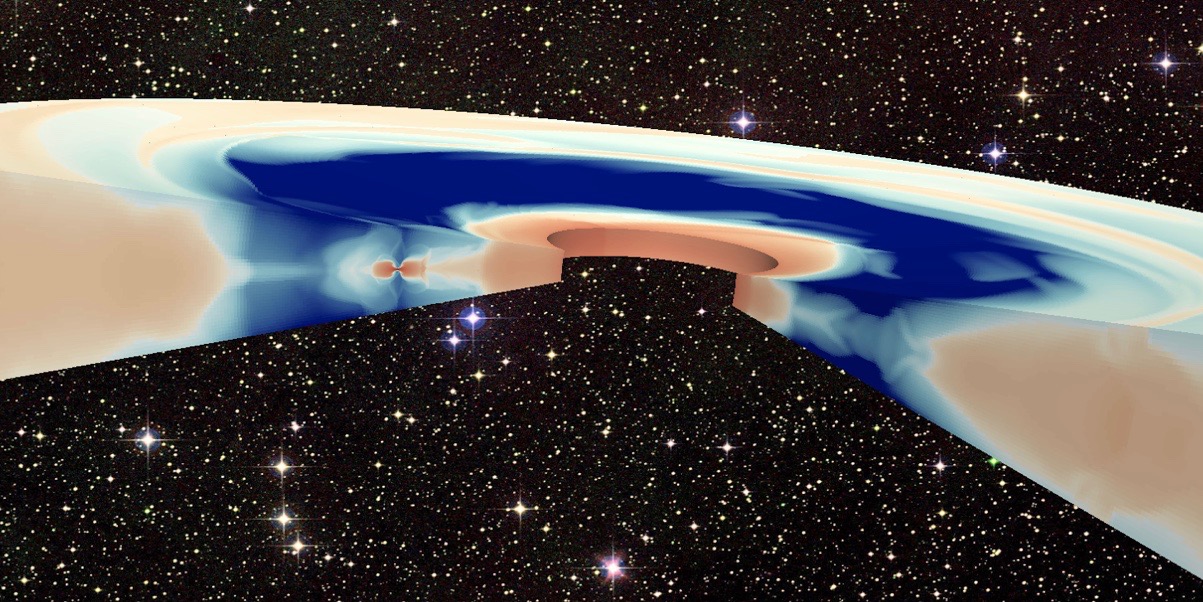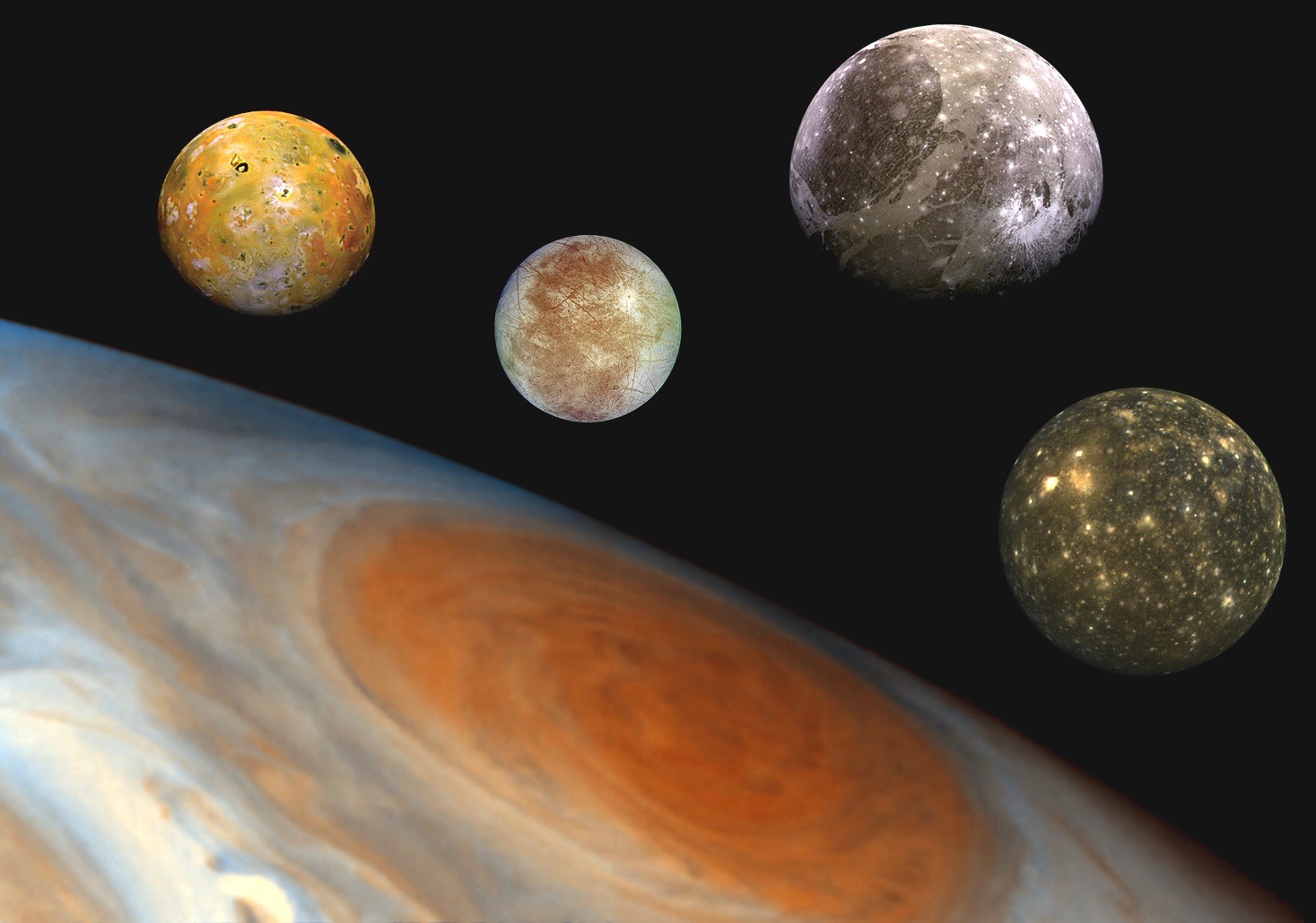How the moons of Jupiter were formed

When astrophysicists of the NCCR PlanetS at the University of Zürich analyzed their computer simulations they were amazed: The formation of the moons of Jupiter happened much faster and later than previously believed. The researchers also found out that the satellites we see today are likely not the only moons that formed around the planet, but the only ones that survived.

Example of a circumplanetary disk embedded in a protoplanetary disk, during the first stages of planet formation. Orange represents high density, blue low density. The structure on the left is the disk that is forming around a young Jupiter. Credits: Judit Szulagyi
When we think about moons, the first thing that come across our minds is our own Moon orbiting Earth. However, astronomers think that moons should be very common in the universe, at least around gas giant planets, like Jupiter. In fact, in our Solar System all outer planets (Jupiter, Saturn, Uranus and Neptune) have a system of natural satellites and rings. Among these, the biggest ones, the so called Galilean moons, are orbiting around the “King of Planets”, Jupiter.
While observational data are providing a lot of material to understand the properties of Jupiter’s moons, it is still puzzling how this satellite system could have formed, on what timescale and when this all happened. To understand this crucial sets of questions was the goal that leaded Marco Cilibrasi, Dr. Judit Szulágyi, Prof. Dr. Lucio Mayer, Dr. Joanna Drażkowska, Prof. Yamila Miguel, and Cassandra Inderbitzi, a research group mainly from the Institute for Computational Science at the University of Zurich, to study the formation process of such satellite systems.
Simulating hundred-thousands of systems
In their work that has been in part carried out within the frame of the NCCR PlanetS, they started from the idea that satellites should have formed together with the young Jupiter in a gas and dust disk that surrounded the planet itself. While the nascent, forming Jupiter was still swiping gas from the protoplanetary disk that surrounded our young Sun, the group’s simulations show that the planet itself were also surrounded by a small gas-and dust disk. This idea coincides with the fact that the orbits of the Galilean satellites are well aligned with the plane of rotation of Jupiter and that their orbits are very close to being perfectly circular. Like planets around the Sun, moons also form in a disk around the giant planets. This disk, commonly known as circumplanetary disk, developed around the gas giant during the last stage of its formation process, being present until Jupiter fully formed thanks to a continuous supply of gas and dust from the protoplanetary disk.
Starting from this scenario, the University of Zurich researchers developed a theoretical model and computer simulations, managing to put together what we know today about the structure of the circumplanetary disk, its evolution, the birth and evolution of the satellites within the disk. In fact, having such a complete but simple model, the research group led by Cilibrasi, Szulágyi and Mayer were able to simulate hundred-thousands of forming Jupiter-like systems with many different initial conditions and characteristics (especially the amount of the dust in the disk and the lifetime of the disk itself). Statistically analyzing the results of the simulations, they were able to put constraints on many of the key points of moon-formation around Jupiter.
Lost satellite-generations
The research group found out that the satellites we see today around Jupiter are likely not the only moons that formed around the planet, but the only ones that survived. “Our model proved that in fact several satellite-system formed around Jupiter after each other which then each ended up migrating into the giant planet, leaving just a last surviving generation” — says Cilibrasi. All this happened within a short period of time of roughly hundred-thousand years. This epoch was the very “last minute” of the formation of Jupiter. According to their model, the most likely time to assemble the Galilean satellites were only 20000 years, that is less than the 1% of the lifetime of the protoplanetary disk of the Sun that formed all the planets in the Solar System. “This super-fast and late formation of moons was very surprising to us, as these are orders of magnitude shorter timescales than it was previously believed” — says Dr. Szulágyi.
The study also provided a stunning, new solution for a long-standing problem. Jupiter’s gaseous envelope is much richer in heavy chemical elements than our Sun, so much that so far astrophysicist could not answer where is this discrepancy coming from. The lost satellite-generations, however could provide a natural solution to this problem: dozens of moons were formed initially that ended up engulfed by the forming planet, these heavy-element rich bodies could be the culprits of the peculiar composition of Jupiter’s envelope. The simulations showed that on average, 15 times the Earth’s mass of moons formed whose short life ended quickly encompassed by Jupiter.
Regarding the composition of the formed moons within this model, the results revealed that most of the last generation satellites were rich in ice, which opens a possibility, that a Europa-like undersurface ocean could be relatively common among the moons of Jupiter-like exoplanets as well.
Looking for moons around exoplanets
The new study is bringing us closer to reveal the secrets of moon-formation in general. Today 3674 exoplanets are known, many of these are giant planets that could have formed their satellite-system similar to Jupiter’s. Therefore, enlightening the process of how the moons around Jupiter formed can guide researchers to estimate how many moons can orbit around exoplanets, some of which we will be able to detect during our lifetime.
The simulations interestingly often led to very massive moons, that are beyond the masses of the Galilean satellites. This is particularly exciting in the view that if massive moons around exoplanets are common, they could be easier to detect by observations, than what was previously anticipated. Using the Hubble and Kepler space telescopes, astronomers already found first evidence of an exomoon candidate orbiting a giant planet around a star called Kepler-1625. The moon’s size would be comparable to Neptune. But this finding is still tentative and has to be confirmed by follow-up observations. The astronomers expect that near-future space telescopes, such as CHEOPS and PLATO might be able to spot such worlds orbiting around extrasolar giant planets. (Marco Cilibrasi)

Picture of the four Galilean satellites compared to Jupiter. Sizes are scaled, while distances are not. Credits: ESA
The Galilean moons
The discovery of the moons of Jupiter happened in 1610, when Galileo Galilei first pointed his telescope to Jupiter and was able to see four little bright points moving around the planet, calling them Medicean satellites, after the grand duke of Tuscany Cosimo II de’ Medici. Today these four moons are simply known as Galilean satellites and they are officially named as the lovers of the god Jupiter: Io, Europa, Ganymede, and Callisto.
Starting with the missions Pioneer 10 and 11 (1973-74) and with the famous Voyager mission (1979), NASA provided scientists from all over the world with spectacular pictures and data, allowing them to understand many interesting properties of Jupiter and together with its four orbiting fellows. For instance, today we know that the three inner satellites are in a so-called resonant configuration (i.e. the orbiting period around Jupiter of Ganymede is twice as the orbiting period of Europa and exactly four times as the Io’s). Thanks to these missions we know the internal structures and layers of these rocky bodies and we also know that probably three of them (Europa, Ganymede and Callisto) host salty water just beneath their surfaces. This is particularly exciting for the scientific community because these undersurface oceans makes the Galilean satellites perfect targets to search for extraterrestrial life. (MC)
Categories: External Newsletter, News

